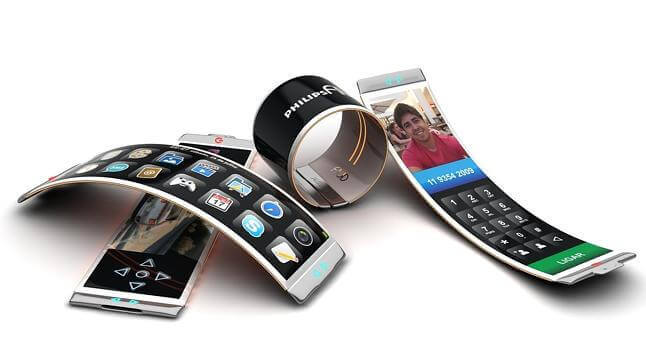The exponential growth of online gaming and entertainment keeps audiences glued to their televisions, tablets, and smartphones for extended periods. Consequently, they demand better visual experiences, which drive display technology innovation. LED technologies such as organic LED (OLED) and micro LED are primarily replacing LCDs to improve display performance. Startups also work on next-generation technologies like quantum dot (QD) displays. This article analyzes the top nine display technology trends and innovations for 2023.
Flexible Displays

Flexible displays are an exciting innovation because they enable thin, lightweight, and one-of-a-kind form factors. Flexible displays are also used in wearables, automotive head-up displays (HUDs), and smartphones because they enable low-cost roll-to-roll manufacturing.
Electronic ink, OLED, gyricon, and organic LCD (OLCD) are some technologies used to create a rollable display. Furthermore, unlike rigid glass substrate-based displays, these displays are less prone to breakage. Electronic paper for dynamic posters and signage, as well as foldable phones, is two primary applications for flexible displays.
SuperUs Systems offers Electronic Paper Devices.
SuperUs Systems is a startup in India that sells electronic paper devices. These e-ink devices use tiny capsules filled with microscopic particles of various colors and electrical charges. Electrodes cause the e-paper surface to reflect a specific color. They are energy efficient because they only consume power when the content on display changes. It is used in the retail and advertising industries for electronic shelf labels, seat tag displays, and other applications.
Immersive Displays

The implementations of immersive display technologies differ by industry. In virtual meeting rooms, for instance, virtual reality (VR) interactive environments offer enhanced perception to increase engagement and learning. Startups and scaleups in display technology are also developing tiny screens and lenses that simulate large screens.
This covers most of a user’s field of view (FOV), allowing for panoramic virtual screens. Simultaneously, such displays provide viewers with interactive augmented realities (AR) via head-mounted presentations (HMDs). Real-time situational awareness enables augmented shopping and improves decision-making. As a result, immersive displays help with convenient, personalized experiences.
Swave Photonics designs Holographic Microchips.
Swave Photonics is a Belgian company that produces holographic microchips. Using diffractive photonics technology, they enable extended holographic reality (HXR) gigapixels. As a result, it can power ultra-high resolution, lifelike 3D displays. Businesses use this technology to hold immersive video conferences while working from a remote location.
Digital Signage
Display technologies, respectively as LCD, LED, projection, and e-paper, are used in digital signage. LCD screen prices are rapidly falling, which increases their integration into digital signage. Startups and scaleups create interactive digital signage with touchscreens, QR codes, or Bluetooth.
They boost user engagement by allowing customers to participate in activities such as polls, games, etc. Furthermore, content management systems (CMS) and digital media distribution systems are used by businesses to run and modify these digital signage displays. They are particularly beneficial for providing public information and sharing brand product information.
PanoScape Holdings offers an Interactive Digital Canvas.
PanoScape Holdings, based in the United States, offers an interactive digital canvas. It combines a cloud-based content management system with real-time analytics. When viewers interact with the screen, the canvas enters an interactive mode. Restaurants and shopping malls use this technology to provide customers with ultra-high-resolution content.
Micro LEDs
Micro LED displays are made up of many microscopic LEDs that self-illuminate each display pixel. Micro LEDs, unlike OLED displays, are made of inorganic materials. As a result, they have shallow black levels and higher peak brightness. Furthermore, the contrast ratio is significantly higher than in OLEDs. Micro LED displays are also modular, utilizing multiple smaller displays to form a larger screen, increasing customizability. Micro LED displays have a long lifetime and lower power consumption, which improves sustainability.
Porotech makes Full Color Micro LEDs.
Porotech is a startup in the United Kingdom that manufactures full-color micro LEDs. DynamicPixelTuning (DPT) technology from the startup allows manufacturers to replace red, green, and blue (RGB) sub-pixels with a single pixel to develop any color in the visible spectrum. As a result, semiconductors are utilizing this technology to improve the engineering of porous GaN materials for displays.
LCDs
To display images, liquid crystal displays use the light-modulating nature of liquid crystals. This display technology is already used in many electronic devices respectively as televisions, computer monitors, digital cameras, and watches. In contrast to large CRT displays, LCDs have compact and thin structures that require less power.
Because OLEDs and micro LEDs are expensive, companies are looking into low-cost applications of LCD in wearables, respectively, as fitness bands. Its market competitiveness stems from using LCDs in low-cost touchscreen devices for industrial applications. Moreover, businesses are using quantum dots to improve the quality of LCD images. However, the production of environmentally hazardous e-waste due to LCDs will force companies to focus on solutions like OLED in the future.
Seeing Display Technology Develops Energy-saving LCDs
Seeing Display Technology is a Taiwanese firm that produces energy-efficient LCDs. MLC, or the startup’s memory-type liquid crystal technology, controls and maintains the light transmission of liquid crystal films or glasses. It accomplishes this by turning on and off the input power, thereby reducing power consumption. Display manufacturers use MLC to reduce carbon emissions.
Laser-based Display Technology
Laser-based display systems have applications in both projection and video technology. Displays in both forms use two or more modulated optical lasers as the light source. As a result, laser-based displays produce high-fidelity, high-definition images with a wide colour gamut and improved viewing comfort.
This implies that the images are always razor-sharp, even when projecting onto uneven or curved surfaces. Edge-emitting diodes, vertical-cavity surface-emitting lasers, and optically pumped semiconductor lasers are good candidates for laser-based displays. These laser systems are also used in pico projectors and laser televisions. Numerous startups and scale-ups focus on developing image quality by addressing issues like laser speckle.
VITREALAB Provides Photonic Integrated Devices
VITREALAB, an Austrian startup, develops integrated photonic devices. They use a quantum light engine of millions of precisely manufactured low-loss optical waveguides. To generate laser lights, the waveguides interact with nano-imprinted micro-optics. Immersive reality companies use these laser lights because of their high brightness and contrast colour quality.



